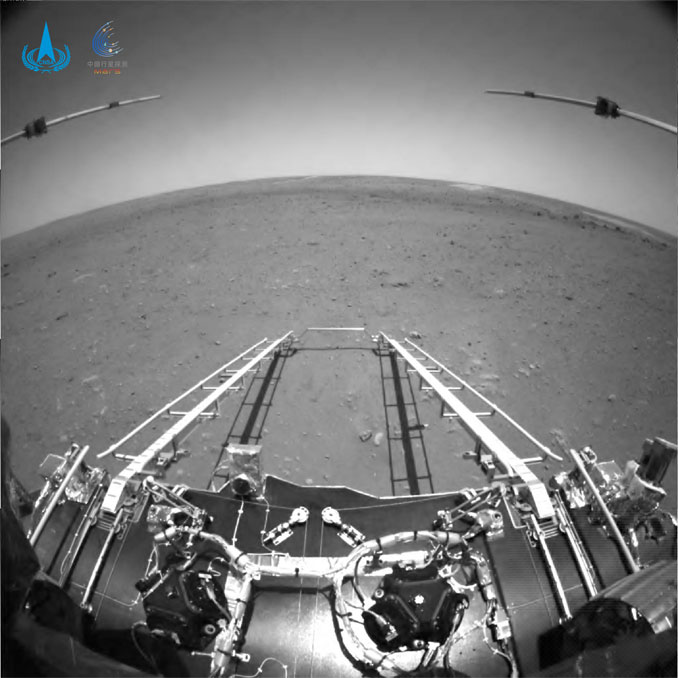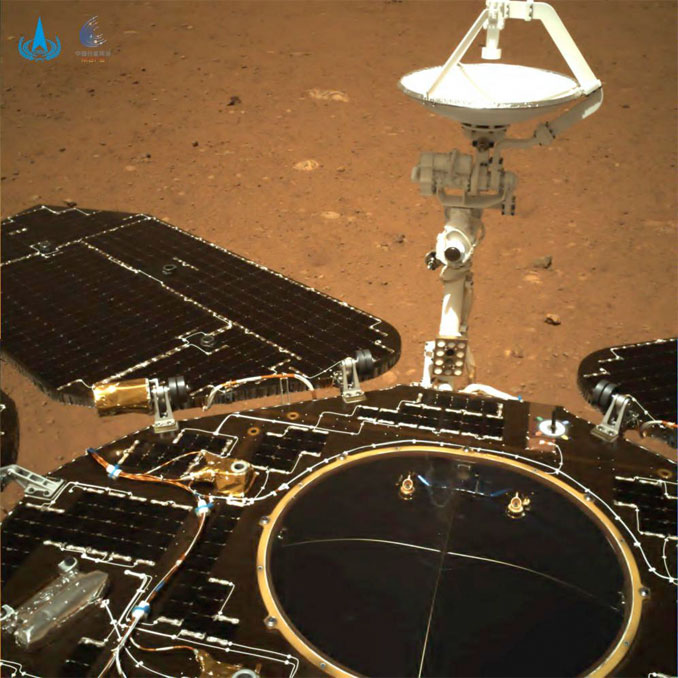
China’s Zhurong Mars rover, still perched atop a rocket-powered lander following touchdown 14 May, has beamed back the first pictures from its Utopia Planitia landing site. A black-and-white photo from a wide-angle hazard avoidance camera shows the rover landed in relatively smooth, obstacle-free terrain while a second colour image shows the rover’s solar arrays and antennas deployed as planned.
If all goes well, Zhurong soon will roll down to the surface using two ramps that have been extended from the top of the lander. The ramps are visible in the black-and-white image, along with two masts that are part of a ground-penetrating radar instrument.
While the rover explores Utopia Planitia at ground level for at least three months, the Tianwen-1 mothership that carried Zhurong to Mars will study the planet from orbit over the course of a planned two-year mission.
The 240-kilogram (530-pound) six-wheel rover is roughly the size of the Spirit and Opportunity rovers that NASA landed on Mars in 2004. Zhurong is equipped with six instruments, including a multi-spectral camera, a terrain camera, a ground-penetrating radar, magnetic field detector and a suite of meteorology sensors.
The Tianwen-1 mother ship is equipped with seven instruments, including high- and medium-resolution cameras; a ground-penetrating radar; a mineralogy spectrometer; a magnetometer; and two charged particle detectors.

“Congratulations to the China National Space Administration on receiving the first images from the Zhurong Mars rover!” newly confirmed NASA Administrator Bill Nelson said in a statement. “As the international scientific community of robotic explorers on Mars grows, the United States and the world look forward to the discoveries Zhurong will make to advance humanity’s knowledge of the Red Planet.
“I look forward to future international discoveries, which will help inform and develop the capabilities needed to land human boots on Mars.”
NASA has successfully sent five rovers to Mars, along with four stationary landers and six orbiters. Two rovers – Curiosity and Perseverance – are still operational, along with the stationary Insight lander and three orbiters: the Mars Odyssey, the Mars Reconnaissance Orbiter and Maven.
Also in Mars orbit are two European Space Agency satellites – Mars Express and ExoMars – along with India’s Mars Orbiter and the Hope mission launched by United Arab Emirates.
While the Zhurong rover is not in the same league with NASA’s nuclear-powered Curiosity and Perseverance, it represents an impressive technological achievement that moves China into the very exclusive club of nations capable of interplanetary exploration.
“Tianwen-1 is going to orbit, land and release a rover all on the very first try,” mission managers wrote before launch in the journal Nature Astronomy. “No planetary missions have ever been implemented in this way. If successful, it would signify a major technical breakthrough.”



